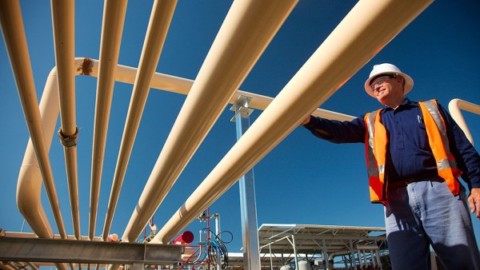By Dr Glen Currie, Program Impact Manager – Energy System, Climateworks Centre
Why is building energy efficient infrastructure important? Due to physical infrastructure lasting 50-100 years, building it to be energy efficient will continue to pay us back for a very long time. This is because ‘negawatts’ – or the watts saved through energy conservation or energy-efficient choices – in buildings, transport and industry are the most cost-effective way to reach zero emissions.
Climate change is exposing Australia to more extreme weather. This means the impacts of climate change are increasingly being felt by businesses and consumers. But it is possible to make Australia’s homes, buildings, industries and transport systems more resilient and energy efficient – at a relatively low cost.
Climateworks Centre recommends energy efficiency be improved across the economy as part of Australia’s energy transition. Our modelling shows energy efficiency in all its forms is not only the cheapest way to reduce emissions, but is also an economic opportunity that creates savings for energy consumers and the energy industry.
Climateworks’ 1.5°C-aligned scenario shows energy efficiency savings of around 280PJ of electricity and gas from buildings, and around 130PJ in industry. Energy efficiency measures are a no regrets solution – they are cost-effective.
What can the industry and transport sector gain from improved energy performance?
The 2023 Pathways to Industrial Decarbonisation report, prepared by Climateworks with CSIRO, shows a further 250 PJ/year can be saved in Australia by improving the efficiency of industrial and manufacturing processes and technologies. For example, the report shows that increased recycling of minerals such as steel, electrification of mining and processing, as well as biodiesel trucks, would see emissions fall soon.
This will require significant investment. By 2030, up to $2.9 billion could be required for technology investments to achieve this emission reduction. Additionally, increased electrification under the 1.5°C scenario outlined in the report would require a rapid scaling up of renewable energy generation and a doubling of total current electricity generation by 2050. In the transport sector, gains can also be made from energy efficiency.
Transport that relies on fossil fuels and the internal combustion engines has a 30 per cent efficiency, whereas the roundtrip energy efficiency for electric vehicles is 80 per cent. The opportunity for efficiency means we can provide transport services with electric motors and reduce oil imports to Australia, and also reduce the energy required for that transport.
Buildings sector provides immediate opportunity
While the opportunities for energy efficiency in industry and transport are huge, it is in the building sector where there is mature technology that can be deployed immediately.

Figure 1: National energy consumption and savings from energy efficiency improvements in buildings, 2016-2050, broken down by fuel. Data Source: Decarbonisation Futures “All-in” 1.5 aligned scenario.
Australia’s eleven million homes are responsible for over ten per cent of its total emissions and more than 25 per cent of electricity consumption. Energy efficiency savings shown in Climateworks’ 1.5°C pathway represent a 39 per cent decrease in national building’s energy consumption by 2030. It is important to improve the energy performance of existing and new homes.
Government action for energy savings
In 2022, the American Council for an Energy-Efficient Economy (ACEEE) released an international energy efficiency scorecard, ranking 25 of the world’s top energy-consuming countries on their energy efficiency and carbon reduction policies and performance. Australia placed 18th.
The Federal Government is now taking action, developing its National Energy Performance Strategy (NEPS). The NEPS could create clear signals to the market and communities, showing how energy performance improvements can contribute to the broader energy transformation. The ACEEE report card shows how much Australia can learn from others with regards to improving performance across the economy.
Australia could set national energy efficiency targets – similar to those set by the European Union – using existing structures to deliver the strategy across Federal, State and Territory Governments. Australia still has the chance to set out a process for the urgent development of 2030 and 2050 sectoral performance metrics and/or targets for residential buildings, commercial buildings, industry and transport.
These would link to existing initiatives, legislation and governance structures such as the recently-legislated Annual Climate Change Statement to Parliament. Performance measures on technology uptake in buildings could be included – and could similarly apply to transport and industry.

Figure 2: Forecast of energy savings through efficiency for industry, residential and commercial customers. Data Source: Decarbonisation Futures “All-in” 1.5 aligned scenario.
Pathway to growing ‘negawatts’
As noted, mature energy efficiency options for buildings are already commercially available. This makes the building sector a good place for governments to begin giving clear direction to the market. Governments could start by developing a comprehensive policy package for improving energy performance in the sector. Such a package would include mechanisms to incentivise the energyefficient and zero-carbon renovation of existing buildings.
Australia could institute appropriate energy efficiency targets and governance, and design national legislation aiming to normalise zero carbon and climate-resilient buildings by 2030. The recent agreement by the Energy and Climate Change Ministerial Council to update the Trajectory for Low Energy Buildings by the end of 2024 will help create momentum towards this goal. This includes updating and introducing new regulations for existing buildings.
Not just for homeowners
People in low income households are particularly vulnerable to the adverse effects of poorly built homes, with recent research by the Australian Council for Social Services confirming that many in these households have difficulty keeping their homes warm in winter and cool in summer.
These households will need support to improve the energy efficiency of their houses. Assistance for these households could include government support for upgrading and building highly efficient social housing and improving low-income housing. This could kickstart energy efficiency supply chains in Australia.
An energy efficiency upgrade program could then be rolled out nationally via mandatory energy assessments for rental homes. Such a program would include training assessors, publishing the collected data and making it accessible for research purposes, and a national roll out of mandatory energy efficiency disclosure for rental properties. This would generate jobs wherever there are buildings.
These regulations could include minimum standards for rental homes by 2025. The Federal Government can collaborate with State and Territory Governments to help them implement such standards.
NEPS can support climate goals
As we’ve seen, energy efficiency is an essential component of Australia’s response to climate change. There is a clear role for all levels of government in improving Australia’s energy performance, given its multiple benefits to business and wider society.
Moving forward, the Federal Government has the opportunity to design the NEPS to support Australia’s climate policy priorities, emissions reductions targets, and long-term goal of net zero emissions in line with the Paris Agreement. This is especially urgent, now more than ever, given the window to keep global warming within 1.5 degrees is still open, but narrowing.

















